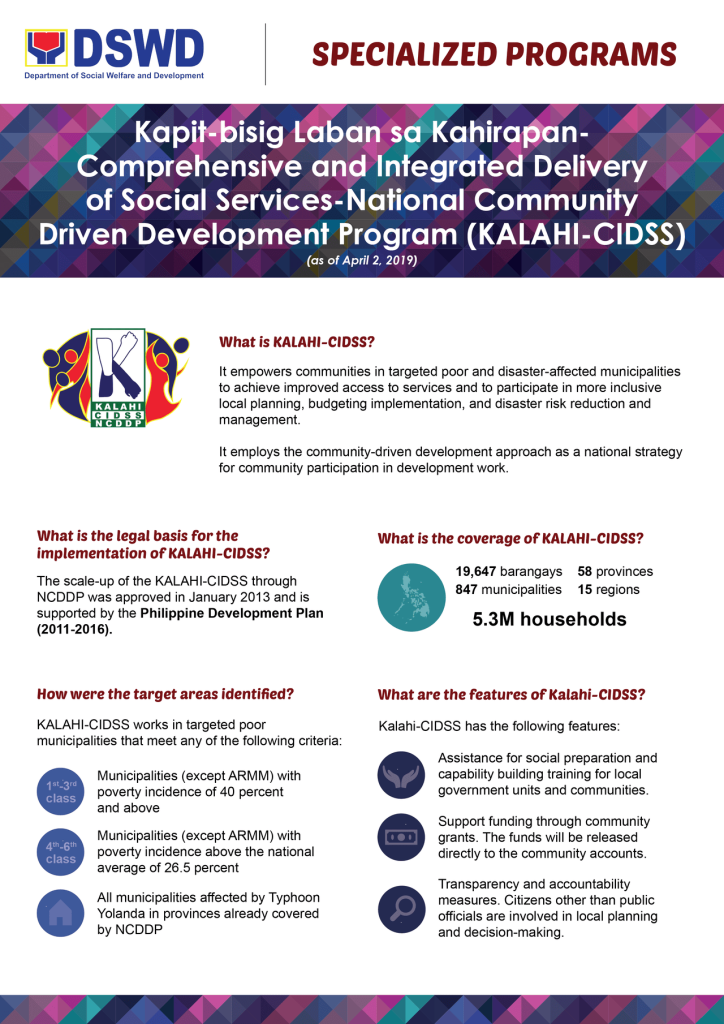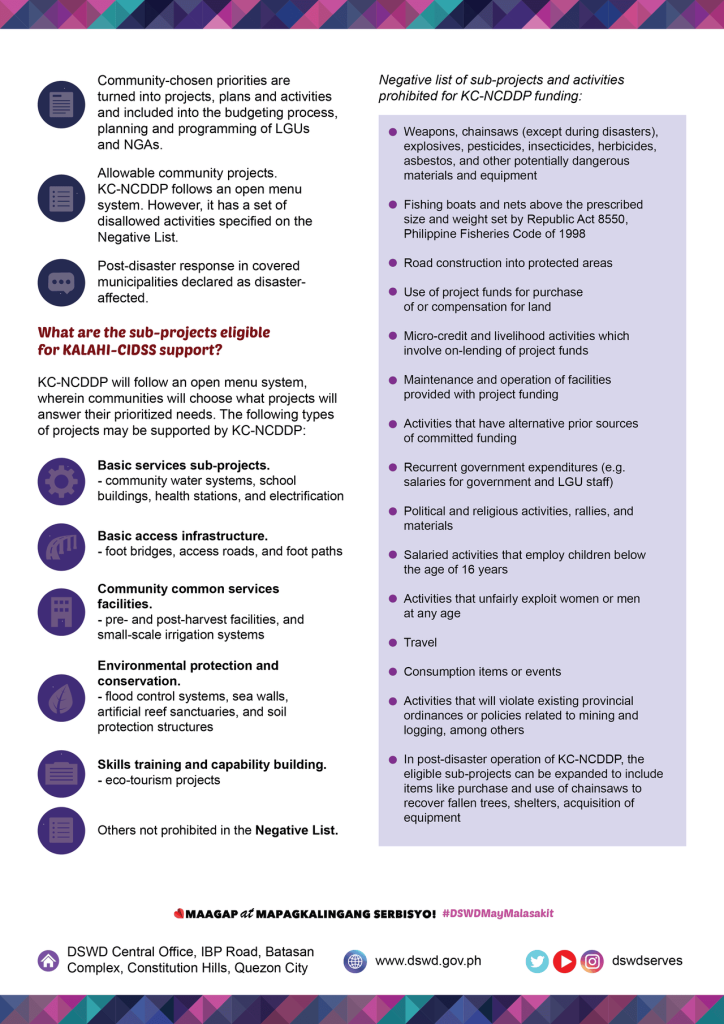The KALAHI-CIDSS (Kapit-Bisig Laban sa Kahirapan – Comprehensive and Integrated Delivery of Social Services) National Community-Driven Development Program (NCDDP) is one of the government’s key initiatives aimed at alleviating poverty in the Philippines. Managed by the Department of Social Welfare and Development (DSWD), this program empowers local communities to engage in development projects that directly address their needs. By involving communities in decision-making and planning, KALAHI-CIDSS ensures more inclusive governance and service delivery.
Understanding how to apply and benefit from KALAHI-CIDSS is essential for residents in eligible municipalities, especially those in impoverished or disaster-affected areas. This guide will walk you through the process of applying, the types of support available, and the benefits you can access through the program.
Program Overview, Scope, and Coverage
The DSWD KALAHI-CIDSS NCDDP is a poverty reduction program designed to improve access to basic services and engage communities in local governance. The program uses the community-driven development (CDD) approach, where local residents, especially the poorest and disaster-affected ones, identify their needs and take part in planning, implementing, and managing development projects. This approach is part of the government’s broader strategy to promote inclusive growth, local empowerment, and effective disaster risk management in poor communities.
The program follows an open menu system, allowing communities to choose projects such as water systems, school buildings, health stations, roads, and flood control measures. The DSWD provides financial support through grants that are released directly to community accounts, ensuring transparency and accountability. Local government units (LGUs) are also involved by providing matching funds for the projects. In general, the programs are meant to provide financial assistance and resources to address specific needs of targeted groups within communities in order to foster sustainable development and social equity.


Types of Projects Funded by KALAHI-CIDSS NCDDP
KALAHI-CIDSS supports various community-driven projects including, but not limited to:
- Basic Infrastructure: Projects like foot bridges, access roads, and electrification.
- Social Services: Building or improving community health centers, school buildings, and daycare centers.
- Environmental Projects: Flood control systems, sea walls, and soil protection structures.
- Capacity Building: Skills training programs and eco-tourism projects that empower communities to sustain development activities.
It’s important to note that certain activities are not allowed under KALAHI-CIDSS, including political or religious activities, and the use of funds for purchasing land.
Benefits of KALAHI-CIDSS for Communities
KALAHI-CIDSS offers numerous benefits to communities, especially those in impoverished and disaster-affected areas. By participating in the program, communities can:
- Improve Local Infrastructure: Projects funded by KALAHI-CIDSS significantly enhance local infrastructure, such as roads, schools, and health facilities, improving access to essential services.
- Boost Local Governance: The program strengthens local governance by fostering transparency, accountability, and community participation in decision-making processes.
- Enhance Skills and Knowledge: Communities gain skills in project management, budgeting, and governance, which can have long-term benefits beyond the lifespan of a single project.
- Increase Resilience to Disasters: KALAHI-CIDSS also supports disaster risk reduction initiatives, making communities better prepared for future natural calamities.
Additional Information on KALAHI-CIDSS Funding
KALAHI-CIDSS provides financial grants directly to communities, with funds released to community-managed accounts. This ensures that resources are used efficiently and that the community retains control over the projects. The program also includes capacity-building efforts, where both local governments and community members receive training on project management, ensuring that they are well-equipped to handle development projects.
The funding process is transparent, with regular monitoring to ensure that funds are used properly. Communities are also encouraged to involve marginalized groups in decision-making, ensuring inclusivity and equal participation.
Target Beneficiaries
The program is designed to specifically help individuals from marginalized and vulnerable sectors of society, like the following:
- Low-income families
- Persons with disabilities (PWDs)
- Senior citizens
- Unemployed or underemployed individuals
- Women and children from impoverished areas
Eligibility Requirements
To qualify for assistance, applicants must meet certain criteria to prove that there are, indeed, those who are most in need.
- Must be a Filipino citizen
- Resident of the designated program areas
- Income or household condition within a set threshold
- Priority for individuals facing economic or social disadvantages
Documentary Requirements from Applicants
Applicants must submit relevant documents to validate their eligibility and ensure proper processing of applications. These include:
- Valid government-issued ID (e.g., voter’s ID, driver’s license)
- Proof of income (e.g., pay slips, tax returns)
- Certification of residency from the local government unit
- Medical or disability certificate (if applicable)
- Recent photo of the applicant
How to Apply for the Kalahi-CIDSS NCDDP Program
Once the community program is all set, individuals from the participating area may apply as beneficiaries of the Kalahi-CIDSS NCDDP program by following these steps:
Step 1. Visit your local government unit (LGU) or community center
Step 2. Attend program orientation or information sessions
Step 3. Fill out the application form provided by the LGU or designated agencies
Step 4. Submit required documents for verification
Step 5. Await notification of approval or further instructions
Where to Get the Application/Registration Form
If you are an individual interested in taking part and becoming a beneficiary of the Kalahi-CIDSS NCDDP program, then you may visit your local government unit (LGU) for more information. The application form for the Kalahi-CIDSS NCDDP program can also be obtained from your local barangay or municipal hall. It is typically available during community orientation sessions or through government-led outreach activities. Local officials or the DSWD can also provide these forms at designated offices.
Video: How KALAHI-CIDSS is Changing Communities
KALAHI-CIDSS is transforming the way communities engage with local development. Watch this video to see real-life examples of how this program is making a difference in communities across the Philippines.
Summary
KALAHI-CIDSS NCDDP is a program designed not only to empower communities and individuals but also to improve access to essential services in the Philippines. By involving residents in the decision-making process, implementation, and funding development projects, the program fosters local ownership and accountability. If you live in an eligible municipality, applying for KALAHI-CIDSS NCDDP can provide your community with vital infrastructure and social services, boosting both local governance and resilience. For further information, check with your local government or visit the DSWD website to learn more about the program.
